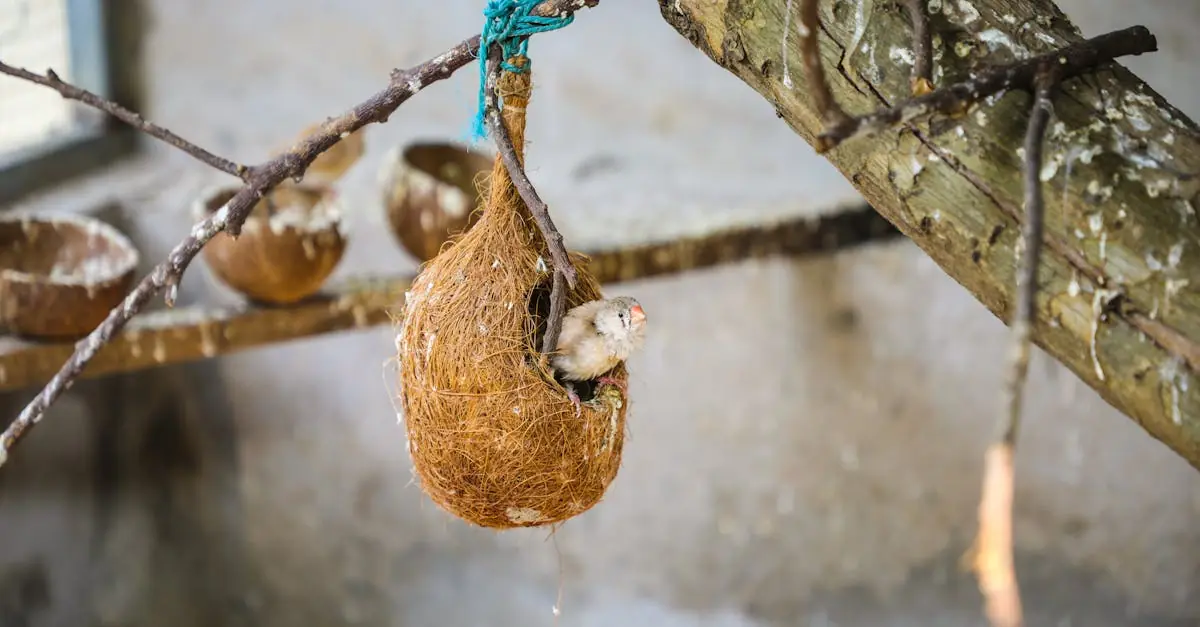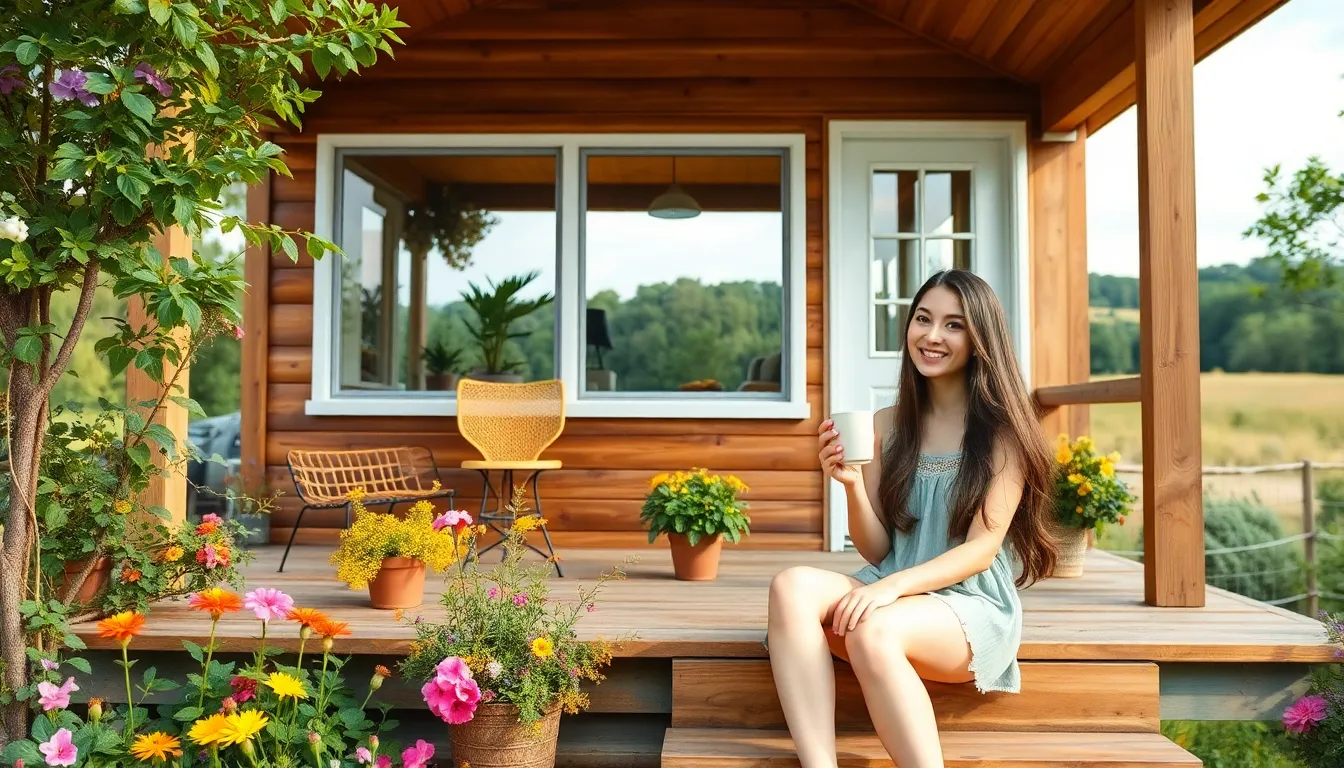Table of Contents
ToggleImagine living in a space that’s both cozy and stylish, where every square foot is a masterpiece. Tiny homes have taken the world by storm, offering a unique blend of simplicity and charm. But let’s face it: the exterior is the first thing that catches the eye, and it can make or break your tiny home’s appeal.
Overview of Tiny Home Exterior
Tiny home exteriors reflect their owners’ personalities and preferences. Many tiny homes feature unique architectural styles, from modern to rustic designs. The choice of materials plays a crucial role in determining durability and aesthetics. Wood siding, metal cladding, and fiber cement are popular options, each offering distinct benefits.
Color selection can dramatically affect the visual impact of a tiny home. Bright hues create an inviting atmosphere, while neutral tones blend with natural surroundings. Windows serve both functional and aesthetic purposes, providing natural light and enhancing views. Large windows often maximize space perception, while strategically placed smaller windows increase privacy.
Landscaping complements the exterior design. Thoughtful plant selections and outdoor features enhance the overall appearance. Decks and patios provide additional outdoor living space, promoting relaxation and entertaining. Furniture, such as benches and tables, can also add to the charm.
Overhangs provide necessary protection from weather elements, extending the life of exterior materials. Roofing options vary widely, with choices like metal and shingles offering different styles and performance. The roof pitch can influence a tiny home’s overall silhouette, creating character.
Lighting contributes significantly to the exterior ambience. Use of solar or LED fixtures enhances safety while decorating the area. It’s essential for safety and practicality as well. Various unique design features may include balconies or porches, giving each tiny home a personal touch. A well-thought-out tiny home exterior not only attracts attention but also ensures functionality and comfort.
Design Elements of Tiny Home Exterior
The exterior of a tiny home combines functionality with creativity. Thoughtful design elements contribute significantly to its overall appeal.
Materials Used
Wood siding creates a warm and natural aesthetic. Metal cladding offers a modern touch and enhanced durability. Fiber cement provides resistance to weather elements while maintaining versatility in style. Each material selection affects the home’s longevity and maintenance needs. Structural integrity stems from these choices, ensuring a lasting investment.
Color Schemes
Bright colors can invigorate the exterior, making the space feel inviting. Neutral tones help the tiny home blend seamlessly with its surroundings. Accent colors can highlight architectural features, adding visual interest. Consistency in the color palette creates harmony and coherence. Color choices reflect personal style, enhancing the tiny home’s individuality.
Popular Styles of Tiny Home Exterior
Tiny homes feature a range of exterior styles, each reflecting different tastes and functionality. Two popular styles are modern aesthetics and rustic charm.
Modern Aesthetic
Clean lines and minimalism define modern tiny home exteriors. Using materials like metal and glass creates a sleek look that emphasizes simplicity. Large windows enhance natural light and blur boundaries between indoors and outdoors. Flat roofs often complement this design, contributing to a contemporary feel. Neutral colors, in shades of gray, white, or black, offer versatility while allowing for bold accents. This style often incorporates eco-friendly elements, such as solar panels and green roofs, promoting sustainability.
Rustic Charm
Rustic tiny homes evoke warmth and coziness with natural materials. Wooden siding, often in reclaimed finishes, emphasizes craftsmanship and authenticity. This style typically features pitched roofs that add character and visual interest. Earthy tones, such as browns and greens, blend harmoniously with surroundings, creating a welcoming atmosphere. Stone accents can be included to provide texture and enhance aesthetic appeal. Outdoor spaces, like porches or decks, often invite relaxation and connection with nature, further exemplifying the rustic charm.
Interior vs. Exterior Considerations
When designing tiny homes, both interior and exterior elements hold equal weight. Each aspect significantly affects the overall vibe and functionality of the living space. Exterior choices often harmonize with interior styles, creating an inviting atmosphere. Attention to materials strengthens the exterior while maintaining durability; this balance ensures a cohesive look throughout the home.
Colors chosen for the exterior should complement the interior palette, enhancing the overall coherence. Unique landscaping enriches the outdoor experience, reflecting the owner’s style. Interior layouts impact how space feels and functions; therefore, open floor plans work well in confined areas. Well-placed windows, both inside and out, optimize natural light, making every square inch feel larger.
Furniture selection inside enhances comfort and usability, mirroring the practical yet stylish approach of the exterior. Outdoor features, like decks or patios, become additional living spaces, encouraging outdoor relaxation. Thoughtful design choices outdoors can extend aesthetic preferences from the interior, reinforcing the home’s identity.
Energy-efficient materials and designs contribute to sustainability, an increasingly important aspect in tiny home construction. Each choice influences maintenance; lighter colors may require more upkeep, while darker tones hide imperfections better. Focusing on utility alongside style connects the interior with the exterior, creating a functional and visually appealing space. Prioritizing these elements promotes seamless transitions and enhances daily living in tiny homes.
Maintenance of Tiny Home Exteriors
Maintaining tiny home exteriors is essential for longevity and appeal. Regular inspections help identify potential issues, such as wear on materials or signs of water damage. Cleaning surfaces regularly ensures that dirt, mold, and mildew don’t accumulate, which can degrade materials over time.
For wood siding, annual staining or sealing protects against moisture and pests. Metal cladding benefits from periodic washing to remove debris and prevent rust. Fiber cement siding generally requires less maintenance but should still be checked for cracks or chips.
Window upkeep involves cleaning both the glass and frames. This practice enhances visibility and prevents deterioration. Checking seals and weather stripping ensures energy efficiency and prevents air leaks.
Landscaping requires attention to promote a healthy environment around the tiny home. Trimming plants and shrubs prevents overgrowth that could damage siding or roofing. Seasonal mulching maintains soil moisture while controlling weeds, which helps in maintaining an inviting exterior.
Roof inspections assist in spotting damage or debris buildup. Clearing gutters and downspouts prevents water from pooling, reducing the risk of structural damage over time. Applying appropriate roofing materials enhances durability and decreases overall maintenance needs.
Lighting fixtures require occasional checks to ensure they function properly. Ensuring that solar or LED lights are clean allows for better performance. This simple upkeep enhances safety and ambience in outdoor spaces, complementing the tiny home’s charm.
Overall, a routine maintenance schedule supports the structural integrity and visual appeal of tiny home exteriors. Implementing these practices promotes a welcoming space that reflects the owner’s personal style while remaining functional.
A well-designed tiny home exterior not only enhances visual appeal but also reflects the owner’s unique personality. By thoughtfully selecting materials colors and architectural styles it’s possible to create a space that feels both inviting and functional.
Incorporating elements like landscaping and outdoor features further enriches the environment promoting a seamless connection with nature. Regular maintenance ensures these exteriors remain vibrant and appealing over time.
Ultimately the exterior of a tiny home serves as a canvas for creativity and individuality while promoting sustainability and comfort. Embracing these design principles can lead to a truly exceptional tiny living experience.



